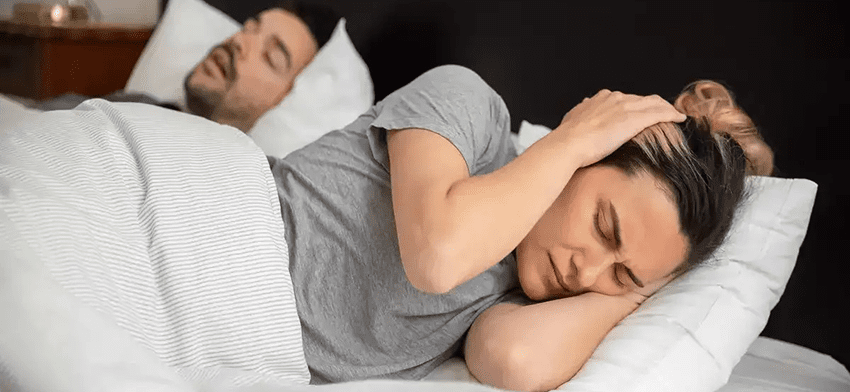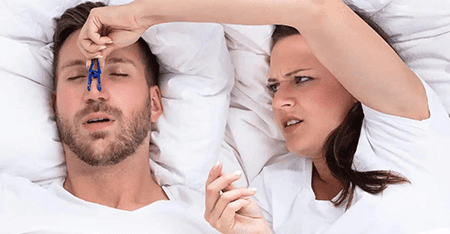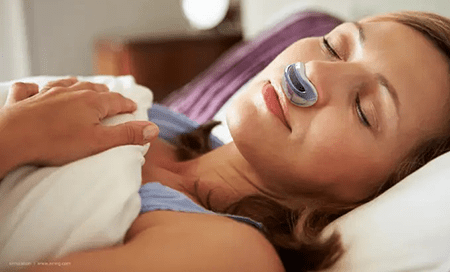Stop the Snoring: 5 All-Natural , Practical & Perfect Solutions for Peaceful Sleep

Overview
Snoring is a common sleep-related issue characterized by noisy breathing during sleep. It occurs when the airway becomes partially blocked, causing the tissues in the throat to vibrate as air passes through. Snoring can vary in intensity and may disrupt the quality of sleep for both the snorer and their partner. While occasional snoring is usually harmless, chronic and loud snoring can be a sign of an underlying sleep disorder, such as sleep apnea. Lifestyle changes, positional therapy, and the use of snoring aids are among the approaches that can help alleviate snoring and improve sleep quality.
5 Solutions for Peaceful Sleep
-
Sleep Positional Therapy: Changing sleep positions can often reduce snoring. Elevating the head with extra pillows or using a specially designed wedge pillow can help keep the airway open and decrease snoring.
-
Weight Management: For overweight individuals, losing weight can significantly improve snoring as it reduces the pressure on the airway, making it less likely to collapse during sleep.
-
Avoid Alcohol and Sedatives: Alcohol and sedatives can relax the throat muscles, leading to increased snoring. Avoiding these substances close to bedtime can help reduce snoring episodes.
-
Nasal Strips and Dilators: Nasal strips can be applied to the nose to widen the nasal passages, while nasal dilators are small devices that keep the nostrils open during sleep, both of which can improve airflow and reduce snoring.
-
Continuous Positive Airway Pressure (CPAP) Therapy: CPAP is a common treatment for obstructive sleep apnea, but it can also be effective in reducing snoring. The CPAP machine delivers a constant flow of air through a mask, preventing the airway from collapsing and reducing snoring.
It’s important to note that while these solutions can be effective for mild to moderate snoring, chronic and severe snoring may require a more comprehensive evaluation and treatment by a medical professional. If snoring is accompanied by other symptoms, such as excessive daytime sleepiness or breathing pauses during sleep, it’s essential to consult a healthcare provider for a proper diagnosis and personalized treatment plan.
Introduction:
Snoring is often associated with a relaxed state of the muscles and tissues in the throat and airways. When these muscles become too relaxed, they can partially block the airflow, causing the surrounding tissues to vibrate. This vibration produces the characteristic snoring sound. Snoring can range from mild, occasional snoring to chronic and loud snoring that can disrupt the sleep of both the snorer and their sleep partner.
The causes of snoring can vary from person to person. One common cause is excess weight or obesity, as the extra weight can put pressure on the airways and restrict airflow. Structural abnormalities in the nose, such as a deviated septum or nasal polyps, can also contribute to snoring. Certain lifestyle factors like smoking, alcohol consumption, and sedative medication can relax the muscles and increase the likelihood of snoring.

Snoring not only affects the quality of sleep but can also have significant implications for overall health. Chronic snoring has been linked to an increased risk of developing cardiovascular problems, including hypertension, heart disease, and stroke. It can also contribute to daytime sleepiness, impaired cognitive function, and decreased productivity. Additionally, snoring can strain relationships, as it can disrupt the sleep of both the snorer and their partner, leading to frustration, resentment, and communication difficulties.
In the following sections, we will delve deeper into the various causes of snoring, its impact on health and daily life, and the available remedies and treatment options. By understanding the underlying factors contributing to snoring and exploring effective interventions, individuals can take proactive steps towards addressing this common sleep disorder and improving their overall well-being.
Snoring Symptoms:
Snoring is characterized by the production of loud, vibrating sounds during sleep due to the obstruction of airflow in the throat and nasal passages. While snoring itself may seem harmless, it can be indicative of underlying issues that affect sleep quality and overall health. Here are some common symptoms associated with snoring:

-
Loud and Disruptive Sounds: Snoring is often described as a loud, raspy, or rumbling noise that can be bothersome to both the snorer and their sleep partner. The sound is produced when the relaxed muscles and tissues in the throat vibrate as air passes through.
-
Daytime Sleepiness: Snoring can disrupt normal sleep patterns, leading to inadequate rest and excessive daytime sleepiness. Individuals who snore may find it difficult to stay alert and focused throughout the day, impacting their productivity and quality of life.
-
Fragmented Sleep: Snoring can cause frequent disruptions in sleep, leading to a fragmented sleep pattern. These interruptions prevent individuals from reaching deep, restorative stages of sleep, resulting in feelings of fatigue even after a seemingly sufficient amount of sleep.
-
Morning Headaches: Snorers may often wake up with headaches, which can be attributed to the intermittent interruptions in breathing and decreased oxygen levels during sleep.
-
Dry Mouth and Sore Throat: Snoring can contribute to mouth breathing, which can cause dryness and irritation in the mouth and throat. Waking up with a dry mouth or a sore throat is a common complaint among snorers.
-
Restless Sleep: Snoring may cause individuals to shift positions frequently during sleep in an attempt to find a more comfortable position that alleviates the snoring. This restlessness can further disrupt the sleep cycle and prevent a restful night’s sleep.
It is important to note that while snoring itself may not always indicate a serious medical condition, it can be a symptom of a more significant underlying issue, such as sleep apnea.
Sleep Apnea Symptoms:
Sleep apnea is a potentially serious sleep disorder characterized by repeated pauses in breathing during sleep. These pauses, known as apneas, can last for seconds to minutes and can occur multiple times throughout the night. Sleep apnea can have detrimental effects on overall health and well-being. Here are some common symptoms of sleep apnea:

-
Loud, Chronic Snoring: Loud and persistent snoring is often a primary symptom of sleep apnea. The snoring is typically more severe in individuals with sleep apnea compared to regular snorers.
-
Gasping or Choking Sounds: Sleep apnea sufferers may experience sudden awakenings accompanied by gasping or choking sounds as they struggle to breathe during episodes of interrupted airflow.
-
Daytime Sleepiness and Fatigue: Sleep apnea disrupts normal sleep patterns, preventing individuals from obtaining restful sleep. This leads to excessive daytime sleepiness, lack of energy, and feeling tired even after a full night’s sleep.
-
Morning Headaches: Sleep apnea can cause frequent morning headaches due to the intermittent interruptions in breathing and reduced oxygen levels during sleep.
-
Difficulty Concentrating and Memory Issues: The sleep disruptions caused by sleep apnea can impair cognitive function, resulting in difficulty concentrating, memory problems, and decreased alertness.
-
Irritability and Mood Changes: Chronic sleep deprivation caused by sleep apnea can lead to irritability, mood swings, and a decreased ability to handle stress.
-
High Blood Pressure: Sleep apnea is associated with an increased risk of hypertension (high blood pressure). The repeated drops in oxygen levels during apnea episodes can contribute to elevated blood pressure levels.
-
Obesity and Weight Gain: Sleep apnea and obesity often coexist, as excess weight can contribute to the development of the condition. However, sleep apnea can also disrupt hormonal regulation, leading to weight gain or difficulties in losing weight.
If you or a loved one experiences these symptoms, it is important to consult a healthcare professional for a proper diagnosis and appropriate treatment.
Chronic Snoring:
Chronic snoring refers to persistent and loud snoring that occurs on a regular basis. It is different from occasional or situational snoring, which can be caused by temporary factors such as illness, allergies, or alcohol consumption. Chronic snoring may be indicative of an underlying condition or sleep disorder, such as sleep apnea. Here are some key points to understand about chronic snoring:

-
Frequency and Duration: Chronic snoring is characterized by regular and prolonged episodes of snoring during sleep. It is not limited to isolated incidents or occasional occurrences.
-
Volume and Intensity: Chronic snorers often produce loud and disruptive snoring sounds that can be heard from a distance. The intensity of the snoring can vary from person to person.
-
Sleep Disruptions: Chronic snoring can lead to fragmented sleep, both for the snorer and their sleep partner. The loud snoring noises can cause awakenings, leading to a lack of restful sleep.
-
Health Implications: While chronic snoring itself may not always indicate a serious health condition, it can be a symptom of underlying issues such as sleep apnea, obesity, or nasal abnormalities. These conditions can have significant implications for overall health and should be evaluated by a healthcare professional.
-
Impact on Relationships: Chronic snoring can strain relationships, particularly for sleep partners who may experience difficulties in falling asleep or staying asleep due to the noise. It is essential to maintain open communication and seek appropriate interventions to address the issue effectively.
If chronic snoring is affecting your sleep quality, causing daytime fatigue, or causing disruptions in your relationship, it is advisable to consult a healthcare professional or a sleep specialist for a comprehensive evaluation and appropriate management strategies.
Causes of Snoring (Stertor):
Stertor can be caused by a variety of factors, ranging from temporary conditions to underlying health issues. Here are some common causes of Stertor:

-
Relaxation of Throat Muscles: During sleep, the muscles in the throat and tongue relax. If they relax too much, they can partially block the airway, leading to Stertor.
-
Nasal Congestion: Nasal congestion, caused by allergies, sinus infections, or other factors, can obstruct the nasal passages and force individuals to breathe through their mouths, increasing the likelihood of Stertor.
-
Obesity: Excess weight, particularly around the neck and throat, can contribute to Stertor. The additional fat tissue can narrow the airway and obstruct the flow of air, resulting in Stertor.
-
Alcohol and Sedatives: Consuming alcohol or sedative medications relaxes the muscles in the throat, which can lead to increased Stertor. These substances can further contribute to obstructed airflow and louder Stertor.
-
Sleep Position: Sleeping on the back can cause the tongue and soft tissues in the throat to collapse backward, obstructing the airway and causing Stertor.
-
Aging: As individuals age, the throat muscles naturally lose tone, making them more prone to collapse during sleep and resulting in Stertor.
-
Structural Abnormalities: Structural issues like a deviated septum, enlarged tonsils or adenoids, or nasal polyps can contribute to Stertor by obstructing the airway.
-
Sleep Apnea: Stertor can be a symptom of obstructive sleep apnea, a sleep disorder characterized by repetitive breathing interruptions during sleep. In sleep apnea, the airway becomes partially or completely blocked, leading to stertor and disrupted breathing.
Nasal Congestion and stertor:
Nasal congestion, or a stuffy nose, can significantly contribute to stertor. Here’s an explanation of the relationship between nasal congestion and stertor:

-
Nasal Passage Blockage: When the nasal passages are congested, either due to allergies, sinus infections, or other factors, the airflow through the nose becomes limited. This forces individuals to breathe through their mouths, which increases the chances of stertor.
-
Mouth Breathing: Nasal congestion often leads to mouth breathing during sleep. Breathing solely through the mouth bypasses the natural filtering and humidifying function of the nose, resulting in a higher likelihood of stertor.
-
Swollen Tissues: Congestion causes the tissues lining the nasal passages to swell and become inflamed. This swelling narrows the nasal airway, making it more difficult for air to pass through freely and increasing the vibrations of the relaxed throat tissues, resulting in stertor.
-
Allergic Rhinitis: Allergies, such as allergic rhinitis, can cause chronic nasal congestion. Allergic reactions trigger inflammation in the nasal passages, leading to congestion and an increased risk of stertor.
-
Treatment Options: Addressing nasal congestion can help reduce stertor. Over-the-counter nasal decongestants or saline nasal sprays can provide temporary relief. If congestion persists or is caused by underlying conditions like allergies or structural abnormalities, it’s advisable to consult a healthcare professional for appropriate treatment options.
Obesity and Stertor:
Obesity is closely associated with an increased risk of snoring. Here’s an explanation of how obesity and snoring are interconnected:

-
Excess Weight Around the Neck: Obesity often leads to the accumulation of excess fat around the neck and throat. This additional weight narrows the airway and restricts the airflow during sleep, contributing to stertor.
-
Increased Tissue Vibration: The presence of excess fat tissue in the throat can cause the relaxed throat muscles to vibrate more intensely during breathing. These vibrations produce the characteristic stertor sounds.
-
Obstructive Sleep Apnea (OSA): Obesity is a significant risk factor for obstructive sleep apnea, a condition characterized by recurrent episodes of complete or partial airway obstruction during sleep. The excess weight can contribute to the collapse of the upper airway, leading to stertor and interrupted breathing.
-
Inflammation and Hormonal Factors: Obesity is associated with chronic low-grade inflammation and hormonal imbalances, which can affect the structure and function of the upper airway. These factors further contribute to stertor and sleep apnea.
-
Weight Loss and Snoring Improvement: Losing weight can have a positive impact on reducing stertor. Weight loss helps to decrease the amount of fat tissue around the throat, which alleviates the narrowing of the airway and reduces the severity of stertor.
-
Lifestyle Modifications: Adopting a healthy lifestyle, including regular exercise, balanced nutrition, and weight management, can help reduce the risk of stertor associated with obesity. Incorporating these lifestyle modifications can lead to improvements in overall health and sleep quality.
Alcohol and Stertor:
Consuming alcohol can exacerbate snoring tendencies. Here’s an explanation of how alcohol consumption and stertor are related:

-
Muscle Relaxation: Alcohol acts as a depressant, causing relaxation of the muscles in the body, including the throat muscles. When these muscles relax excessively, they can partially block the airway and increase the likelihood of stertor.
-
Increased Airway Resistance: Alcohol consumption leads to increased airway resistance, making it harder for air to flow freely during breathing. The narrowed airway and turbulent airflow contribute to the vibrations of the relaxed throat tissues, resulting in stertor.
-
Intensified Snoring Sounds: Alcohol can make snoring sounds louder and more intense. The relaxation of the throat muscles combined with the increased airway resistance amplifies the vibrations, creating louder stertor noises.
-
Disrupted Sleep Architecture: Alcohol can disrupt the normal sleep architecture, leading to fragmented sleep. This further contributes to stertor and can result in daytime sleepiness and reduced sleep quality.
-
Avoiding Alcohol Before Bed: Limiting or avoiding alcohol consumption, particularly in the hours leading up to bedtime, can help reduce stertor. This allows the muscles in the throat to remain more toned, decreasing the likelihood of stertor.
It’s important to address the underlying causes of stertor to improve sleep quality and overall well-being. If stertor persists or significantly affects sleep quality, it is advisable to consult a healthcare professional for a comprehensive evaluation and appropriate management strategies.
Note: The information provided in this article is for educational purposes only and should not replace professional medical advice.
Treatment of Snoring (Stertor):
Stertor can be effectively managed through various treatment approaches. Here are some general lines about the treatment options available for Sterto:
-
Lifestyle Modifications: Making certain lifestyle changes can help reduce Sterto. These include maintaining a healthy weight, exercising regularly, avoiding alcohol and sedatives before bed, establishing a regular sleep schedule, and sleeping on your side instead of your back.
-
Sleep Positioning: Changing sleep positions can sometimes alleviate Sterto. Elevating the head of the bed or using pillows to elevate the upper body can help keep the airways open and reduce Sterto.
-
Nasal Decongestion: Addressing nasal congestion, whether through over-the-counter nasal decongestants, saline nasal sprays, or other remedies, can improve nasal airflow and decrease Sterto.
-
Allergy Management: If allergies contribute to Sterto, managing allergic rhinitis or other allergic conditions through medication or allergen avoidance can help alleviate Sterto symptoms.
Snoring Remedies:
Sterto remedies encompass various non-invasive approaches that can help reduce or alleviate Sterto. Here’s an explanation of some effective Sterto remedies:
-
Oral Appliances: Oral appliances, such as mandibular advancement devices or tongue-retaining devices, can be custom-fitted by a dentist. These devices work by repositioning the jaw or tongue to keep the airway open during sleep, reducing Sterto.
-
Continuous Positive Airway Pressure (CPAP): CPAP therapy is a common treatment for obstructive sleep apnea and severe Sterto. It involves wearing a mask over the nose or nose and mouth during sleep. The mask is connected to a machine that delivers a continuous stream of pressurized air, keeping the airway open and preventing Sterto.
-
Positional Therapy: Positional therapy involves using special devices or techniques to encourage sleeping in positions that minimize Sterto. For example, wearing a backpack with tennis balls sewn onto the back can make sleeping on the back uncomfortable and encourage side sleeping.
-
Oral Exercises and Therapy: Certain oral exercises and therapies aim to strengthen the muscles in the throat and tongue, reducing the likelihood of Sterto. These exercises can be performed regularly and may be recommended by a speech therapist or sleep specialist.
-
Natural Remedies: Some natural remedies, such as nasal strips, essential oils, or herbal remedies, are believed to help reduce Sterto. While the evidence for their effectiveness may vary, individuals may find relief from incorporating these remedies into their nighttime routine.
Anti-Snoring Devices:
Anti-Sterto devices are designed to help alleviate Sterto by improving airflow or preventing the collapse of the airway during sleep. Here’s an explanation of common anti-Sterto devices:
-
Nasal Dilators: Nasal dilators are small devices inserted into the nostrils to help keep the nasal passages open. They work by widening the nostrils and improving airflow, reducing the likelihood of Sterto.
-
Nasal Strips: Nasal strips are adhesive strips that are placed on the outside of the nose. They work by gently lifting the nasal passages, increasing the space for airflow, and reducing nasal congestion, which can alleviate Sterto.
-
Mandibular Advancement Devices (MADs): MADs are oral appliances worn in the mouth during sleep. They work by repositioning the jaw slightly forward, which helps keep the airway open and reduces Sterto.
-
Tongue-Retaining Devices (TRDs): TRDs are oral appliances that hold the tongue in a forward position during sleep. By preventing the tongue from falling back and obstructing the airway, TRDs can help reduce Sterto.
-
Positional Therapy Devices: Positional therapy devices, such as specialized pillows or wearable devices, are designed to encourage side sleeping or discourage sleeping on the back. By promoting proper sleep positioning, these devices can minimize Sterto.
Snoring Surgery:
In some cases, when conservative measures fail to address Sterto, surgical intervention may be considered. Here’s an explanation of Sterto surgery options:
-
Uvulopalatopharyngoplasty (UPPP): UPPP is a surgical procedure that involves removing excess tissue from the throat, including the uvula and parts of the soft palate. This surgery helps widen the airway and reduce tissue vibrations that cause Sterto.
-
Palatal Implants: Palatal implants involve inserting small polyester rods into the soft palate. These rods stiffen the tissue, preventing it from collapsing and reducing Sterto.
-
Laser-Assisted Uvulopalatoplasty (LAUP): LAUP is a procedure that uses laser technology to remove or reshape the uvula and surrounding tissues. This surgery aims to increase the size of the airway and reduce Sterto.
-
Radiofrequency Ablation (RFA): RFA is a minimally invasive procedure that uses radiofrequency energy to heat and shrink excess tissue in the throat. This helps to improve airflow and reduce Sterto.
-
Septoplasty and Turbinate Reduction: In cases where a deviated septum or enlarged nasal turbinates contribute to Sterto, surgical procedures like septoplasty or turbinate reduction may be performed to correct these structural issues and improve nasal airflow.
Sterto surgery is typically considered when other treatments have been ineffective or when Sterto is caused by specific anatomical abnormalities. It’s important to consult with a qualified healthcare professional to determine the most appropriate treatment option based on individual circumstances.
Lifestyle Changes for Snoring (Stertor):
Making certain lifestyle changes can play a significant role in managing stertor. Here are some general lines about lifestyle modifications that can help alleviate stertor:
-
Maintain a Healthy Weight: Weight loss can reduce the severity of stertor. Shedding excess pounds can help decrease the amount of fatty tissue around the throat, which may contribute to stertor by narrowing the airway.
-
Adopt Healthy Sleep Habits: Establishing healthy sleep habits can improve sleep quality and minimize stertor. Maintain a consistent sleep schedule, create a comfortable sleep environment, and ensure you get an adequate amount of sleep each night.
-
Practice Side Sleeping: Sleeping on your side can help prevent stertor in some individuals. This sleep position helps keep the airway open by reducing the likelihood of the tongue and other throat tissues obstructing the airflow.
Weight Loss and Stertor:
Weight loss plays a crucial role in managing stertor, particularly in individuals who are overweight or obese. Here’s an explanation of how weight loss can alleviate stertor:
Excess weight, especially around the throat area, can contribute to the narrowing of the airway, leading to stertor. When a person loses weight, the amount of fatty tissue around the throat reduces, allowing for better airflow during sleep. This, in turn, can minimize or eliminate stertor.
Adopting a healthy lifestyle that includes regular physical activity and a balanced diet can help achieve weight loss goals. Engaging in exercises that target the muscles of the throat and airway, such as specific throat exercises, may also be beneficial in reducing stertor.
Healthy Sleep Habits:
Developing healthy sleep habits can significantly improve sleep quality and reduce stertor. Here’s an explanation of some healthy sleep habits:
-
Stick to a Regular Sleep Schedule: Establishing a consistent sleep schedule by going to bed and waking up at the same time every day helps regulate the body’s internal clock and promotes better sleep quality. This can minimize the occurrence of stertor.
-
Create a Comfortable Sleep Environment: Ensure that your sleep environment is conducive to quality sleep. Keep the bedroom quiet, dark, and at a comfortable temperature. Use comfortable pillows and a mattress that provides adequate support.
-
Practice Relaxation Techniques: Engage in relaxation techniques, such as deep breathing exercises, progressive muscle relaxation, or meditation, before bed to promote relaxation and reduce muscle tension, potentially alleviating stertor.
-
Avoid Stimulants and Sedatives: Limit the consumption of stimulants like caffeine and avoid the use of sedatives or sleep aids, as they can interfere with sleep quality and potentially worsen stertor.
-
Maintain Proper Sleep Hygiene: Follow good sleep hygiene practices, such as avoiding heavy meals close to bedtime, avoiding electronic devices before bed, and creating a calming bedtime routine to signal your body that it’s time to sleep.
Side Sleeping:
Sleeping on your side can help prevent stertor in some individuals. Here’s an explanation of how side sleeping can alleviate stertor:
When you sleep on your back, the tongue and other throat tissues are more likely to collapse backward, partially blocking the airway and causing stertor. Sleeping on your side can help keep the airway open and allow for smoother airflow, reducing the chances of stertor.
To encourage side sleeping, you can use pillows or positional devices that provide support and help maintain the desired sleep position throughout the night. Some individuals find it helpful to sew a tennis ball onto the back of their sleepwear to prevent rolling onto their back during sleep.
Incorporating these lifestyle changes and healthy sleep habits into your routine can significantly reduce stertor and improve overall sleep quality. It’s important to note that if stertor persists or worsens despite these changes, it’s advisable to consult with a healthcare professional for a comprehensive evaluation and appropriate treatment.
Sleep Environment for Snoring (Stertor):
Creating a conducive sleep environment is essential for managing stertor. Here are some general lines about optimizing the sleep environment to minimize stertor:
-
Control Bedroom Humidity: Maintaining an optimal level of humidity in the bedroom can help alleviate stertor. Dry air can irritate the airways, leading to increased congestion and potentially worsened stertor. Using a humidifier or ensuring proper ventilation can help keep the air moist and reduce nasal congestion.
-
Choose the Right Mattress: The type and quality of the mattress can impact stertor. An appropriate mattress that provides adequate support and comfort can help promote better sleep posture and minimize stertor. Selecting a mattress that suits your preferences and provides proper spinal alignment is crucial.
-
Implement Noise Reduction Strategies: Reducing excessive noise in the sleep environment can improve sleep quality and reduce disturbances that may contribute to stertor. Employing noise-reducing techniques can create a quieter and more peaceful sleep environment.
Bedroom Humidity:
Optimal humidity levels in the bedroom can have a positive impact on stertor. Here’s an explanation of how bedroom humidity can affect stertor:
Dry air in the bedroom can cause nasal and throat tissues to become dry and irritated, leading to increased congestion and potentially exacerbating stertor. Using a humidifier to add moisture to the air can help keep the nasal passages and airways moist, reducing congestion and improving airflow.
It’s important to monitor humidity levels and aim for a comfortable range, typically between 40% and 60% relative humidity. This can help alleviate nasal congestion, minimize throat dryness, and potentially alleviate stertor symptoms.
Mattress and Stertor:
The type of mattress you sleep on can impact stertor. Here’s an explanation of how the choice of mattress can influence stertor:
An appropriate mattress that provides adequate support and comfort can help maintain proper sleep posture and alignment of the airways, potentially reducing stertor. A mattress that is too soft or sagging may lead to poor spinal alignment, causing the throat and airways to become more constricted during sleep.
Choosing a mattress with medium to firm support, depending on individual preference, can help promote proper alignment of the head, neck, and spine. This alignment can help keep the airways open and reduce the likelihood of stertor.
Additionally, selecting a mattress that minimizes motion transfer can be beneficial for individuals who sleep with a partner, as less disturbance during sleep can contribute to better overall sleep quality and potentially lessen stertor.
Noise Reduction:
Excessive noise in the sleep environment can disrupt sleep and contribute to stertor. Here’s an explanation of how noise reduction strategies can help minimize stertor:
Noise can interfere with sleep, leading to lighter and more fragmented sleep patterns. This can potentially exacerbate stertor and lead to increased daytime sleepiness. Implementing noise reduction strategies can create a more peaceful sleep environment.
Consider using earplugs or white noise machines to mask external noises that may disturb sleep. Soundproofing the bedroom by using thick curtains, carpets, or acoustic panels can also help reduce noise infiltration from outside sources.
Additionally, establishing a bedtime routine that promotes relaxation and reduces stress can contribute to a quieter sleep environment. Practicing relaxation techniques, such as deep breathing or meditation, can help calm the mind and promote better sleep quality, potentially alleviating stertor.
By optimizing the bedroom humidity, choosing an appropriate mattress, and implementing noise reduction strategies, individuals can create a sleep environment that supports better sleep quality and may reduce stertor. It’s important to personalize these strategies based on individual preferences and seek professional advice if stertor persists or worsens.
Health Consequences of Snoring (Stertor):
Sustained stertor can have various health consequences that extend beyond the annoyance of disrupted sleep. Here are some general lines about the potential health impacts of stertor:
-
Impact on Heart Health: Stertor has been associated with an increased risk of cardiovascular conditions. The repeated interruptions in breathing during sleep can strain the cardiovascular system, leading to high blood pressure, heart rhythm abnormalities, and an increased risk of heart disease.
-
Connection to Sleep Apnea: Stertor is often a common symptom of sleep apnea, a sleep disorder characterized by repeated pauses in breathing during sleep. Sleep apnea can have significant health implications, including an increased risk of hypertension, stroke, and heart disease.
-
Daytime Fatigue and Impaired Functioning: The disrupted sleep caused by stertor can result in excessive daytime fatigue and sleepiness. This can affect daily functioning, productivity, and overall quality of life. Individuals may experience difficulties concentrating, irritability, and an increased risk of accidents.
Stertor and Heart Health:
Stertor can impact heart health and increase the risk of cardiovascular problems. Here’s an explanation of the connection between stertor and heart health:
The repeated interruptions in breathing during stertor can lead to drops in oxygen levels and disruptions in the sleep cycle. These disruptions can trigger a cascade of physiological changes, including increased sympathetic nervous system activity and elevated blood pressure. Over time, these factors can contribute to the development or worsening of hypertension, heart rhythm abnormalities, and other cardiovascular conditions.
It’s important for individuals experiencing stertor to consult with a healthcare professional to assess their risk factors for heart disease and monitor their cardiovascular health appropriately.
Stertor and Sleep Apnea:
Stertor is commonly associated with sleep apnea, a sleep disorder characterized by repeated episodes of complete or partial airflow obstruction during sleep. Here’s an explanation of the relationship between stertor and sleep apnea:
Stertor can be a symptom of obstructive sleep apnea, where the airway becomes partially or completely blocked, leading to pauses in breathing. Sleep apnea is a serious condition that can significantly impact overall health. It is associated with an increased risk of cardiovascular problems, including hypertension, stroke, and heart disease.
If stertor is accompanied by other symptoms such as loud snoring, frequent awakenings, gasping or choking during sleep, and excessive daytime sleepiness, it’s important to consult a healthcare professional for further evaluation and potential diagnosis of sleep apnea.
Stertor and Daytime Fatigue:
The disrupted sleep caused by stertor can result in daytime fatigue and impaired functioning. Here’s an explanation of how stertor can contribute to daytime fatigue:
The repeated disruptions in sleep caused by stertor can prevent individuals from reaching deep, restorative stages of sleep. As a result, they may experience excessive daytime sleepiness, difficulty staying awake and alert during the day, and a general feeling of fatigue. This can impact daily functioning, productivity, and overall quality of life.
Addressing stertor and improving sleep quality can help alleviate daytime fatigue. Seeking medical advice and implementing appropriate treatment strategies can significantly improve sleep patterns, reduce stertor-related disruptions, and enhance daytime wakefulness.
It’s crucial for individuals experiencing stertor and its associated health consequences to consult with a healthcare professional for proper evaluation, diagnosis, and management. Treatment options, such as lifestyle changes, positional therapy, oral appliances, or continuous positive airway pressure (CPAP) therapy, may be recommended based on individual circumstances and the presence of underlying sleep disorders like sleep apnea.
Related Links
Conclusion:
In conclusion, stertor is a common sleep disorder that affects many individuals worldwide. It is characterized by the loud, vibrating sound produced during sleep due to the obstruction of airflow through the passages at the back of the mouth and nose. While stertor may seem like a mere annoyance, it can have significant implications for both physical and mental well-being.
The causes of stertor can vary, ranging from nasal congestion and obesity to alcohol consumption and sleep apnea. Understanding the underlying factors contributing to stertor is crucial for effective management and treatment. Lifestyle changes, such as weight loss, adopting healthy sleep habits, and practicing side sleeping, can play a significant role in reducing stertor and improving sleep quality.
Various remedies and treatment options are available to alleviate stertor and its associated health consequences. These include anti-stertor devices, such as nasal dilators or oral appliances, as well as surgical interventions for severe cases. Additionally, creating a sleep environment that promotes relaxation, optimizing bedroom humidity, and minimizing noise can further contribute to reducing stertor.
It is important to note that persistent stertor should not be ignored, as it may indicate an underlying sleep disorder, such as sleep apnea. Seeking medical advice and diagnosis from a healthcare professional is essential for developing a personalized treatment plan.
Addressing stertor can lead to improved sleep quality, reduced daytime fatigue, and enhanced overall well-being. By understanding the causes, implementing appropriate lifestyle changes, and considering available treatment options, individuals can take proactive steps towards managing stertor and achieving restful, rejuvenating sleep.
Remember, each person’s experience with stertor may be unique, and it is advisable to consult with a healthcare professional for a comprehensive evaluation and personalized guidance. Taking proactive measures to address stertor can lead to better sleep and ultimately enhance the quality of life.
Q: 1. What is stertor?
A: Stertor is a sleep disorder characterized by loud, vibrating sounds produced during sleep due to the obstruction of airflow through the passages at the back of the mouth and nose. It is commonly known as snoring.
Q: 2. Can stertor affect heart health?
A : Yes, prolonged stertor can strain the cardiovascular system and increase the risk of cardiovascular conditions such as high blood pressure, heart rhythm abnormalities, and heart disease.
Q: 3. Is stertor associated with sleep apnea?
A : Yes, stertor can be a symptom of obstructive sleep apnea, a sleep disorder characterized by repeated episodes of airflow obstruction during sleep. Sleep apnea is a serious condition that requires medical attention.
Q: 4. What are some lifestyle changes that can help reduce stertor?
A : Lifestyle changes such as weight loss, adopting healthy sleep habits, and practicing side sleeping can help reduce stertor. These changes promote better airflow and improve sleep quality.
Q: 5. Are there any devices or surgeries to treat stertor?
A : Yes, there are anti-stertor devices available, such as nasal dilators or oral appliances, that can help alleviate stertor. In severe cases, surgical interventions may be recommended to address anatomical abnormalities causing stertor.
More Links
Snoring |


